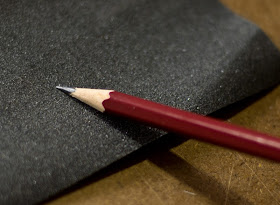I found that the paper's characteristics somewhat changed. It was more absorbent and its surface was not as robust as I remembered. I realised it when I used the wet washes and lifting technique frequently. I wonder whether it changed since I brought it back to Yogyakarta and neglected it for about 7 months.
 I am still wondering how to solve the humidity problem in the tropical
Indonesia. The Japanese Chrysanthemum was not the only one that had been
affected. I faced the same problem when working on the Paphiopedilum
glaucophyllum orchids. Not to mention my shocking encounter with the massive mold attack
on my other drawings when I left them on the hardboard for 4 days only
(when I was in the hospital, giving birth to my baby). The weather was so
humid, it seemed to pose the watercolour paper with many risks. Does anyone of my kind readers here have any idea as to how to solve the problem?
I am still wondering how to solve the humidity problem in the tropical
Indonesia. The Japanese Chrysanthemum was not the only one that had been
affected. I faced the same problem when working on the Paphiopedilum
glaucophyllum orchids. Not to mention my shocking encounter with the massive mold attack
on my other drawings when I left them on the hardboard for 4 days only
(when I was in the hospital, giving birth to my baby). The weather was so
humid, it seemed to pose the watercolour paper with many risks. Does anyone of my kind readers here have any idea as to how to solve the problem? Back to the unfinished painting, I tried some new green mixing I learnt from artistnetwork. I bought Winsor & Newton Permanent Sap Green and I found it was easy to mix with my existing colours. But what made me happy was that the sap green mixing was not as staining as Winsor Blue (green shade) that I usually use. It made lifting the pigment easier both when the paint was still wet/damp and when it completely dried. I mixed sap green with French Ultramarine to get a dark green, or Cadmium Lemon/ Cadmium Yellow Pale to get the bright one. And a little touch of Alizarin Crimson, if needed.
Another new thing I tried was using kolinsky sable brushes as my main tool. I decided to invest in Raphael series 8404 no 2 and 4 after Billy Showell's demonstration. I found the natural brushes was very different from my existing synthetic one (mostly Pro Arte series 101). Here are my first impressions of using Raphael kolinsky sable brushes:
 1. They are bigger than the synthetic ones with the same number size. The Raphael size 4 is even a bit bigger than my Pro Arte size 6.
1. They are bigger than the synthetic ones with the same number size. The Raphael size 4 is even a bit bigger than my Pro Arte size 6.2. They have much bigger capacity to hold water. It is good for glazing/washing big area, on the other hand, it requires more watercolour mixing prepared. [Tips] Use a cheap/discarded brush to pick up pigments and mix watercolour rather than using an expensive sable brush.
3. They release water/paints slower but more evenly. So they tend not to dump water/paints in a puddle.
4. The tuft/hair is softer and bend more easily (or somewhat a bit defenselessly for me).
5. The brushes' tip do not naturally point out when dry (whereas the synthetic do) and need to be reshaped when wet (whereas the synthetic needn't). I was aware of it since I saw Billy kept twirling her brushes' tip on a kitchen towel after she dipped them in water/paints.
[Tips] I reshape the brush by loading the brush with water, then shaking the excess vigorously with my elbow or tapping the brush handle with my other hand before I dip it in the watercolour mixing. I usually have the brush tip very pointed afterward without touching my finger on it.
The kolinsky sable brushes are not cheap, but at least now I know the difference between them and the synthetic ones. I need much more practise to feel more comfortable with them. However, as other people said: knowing how to best use what you have is more important than the "tool" itself. Cheers!
Another post about taking care watercolour brushes is here.
And here is the scanned illustration.
28 x 38 cm - 300 gsm traditional white HP Fabriano Artistico paper.






































